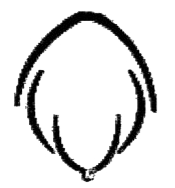Type of aestivation without overlapping of perianth member is
Valvate aestivation
Vexillary aestivation
Ascendingly imbricate aestivation
Twisted aestivation
The correct Answer is:A
To determine the type of aestivation without overlapping of perianth members, we can follow these steps:
1. Understand Aestivation: Aestivation refers to the arrangement of petals or sepals in a flower bud before it opens. It is crucial to identify the different types of aestivation based on how the floral parts are arranged.
2. Identify Types of Aestivation: There are several types of aestivation:
- Valvate Aestivation: The petals or sepals touch each other at the edges but do not overlap.
- Vexillary Aestivation: One petal (the vexillum) is larger and overlaps the two smaller lateral petals.
- Imbricate Aestivation: The petals overlap each other, with some petals covering others.
- Twisted Aestivation: The petals are arranged in a spiral manner, with each petal overlapping the next.
3. Focus on Non-Overlapping Types: Since the question specifically asks for a type of aestivation without overlapping, we need to focus on the types that do not involve any overlapping of petals or sepals.
4. Identify the Correct Type: Among the types mentioned, Valvate Aestivation is the only type where the petals or sepals are adjacent to each other without overlapping.
5. Conclusion: Therefore, the type of aestivation without overlapping of perianth members is Valvate Aestivation.
Final Answer:
The type of aestivation without overlapping of perianth members is Valvate Aestivation.
---
- Valvate Aestivation: The petals or sepals touch each other at the edges but do not overlap.
- Vexillary Aestivation: One petal (the vexillum) is larger and overlaps the two smaller lateral petals.
- Imbricate Aestivation: The petals overlap each other, with some petals covering others.
- Twisted Aestivation: The petals are arranged in a spiral manner, with each petal overlapping the next.
The type of aestivation without overlapping of perianth members is Valvate Aestivation.
Similar Questions
Knowledge Check
- Question 1 - Select One
Perianth refers to
ANonessential floral orgensBEssential floral orgensCFused stamens and carpelsDUndifferentiated calyx and corolla - Question 2 - Select One
Type of aestivation shown by Pisum is :
AImbricateBVexillaryCTwistedDQuincuncial - Question 3 - Select One
Which of the following aestivation involves non-uniform overlapping of petals?
AValvateBTwistedCImbricateDContorted
What is perianth ?
View SolutionWhat is perianth ?
View SolutionThe given figure represents a type of aestivation.

The type of aestivation shown in the given figure is known asView SolutionIdentify the types of aestivation in the following diagram -
 View Solution
View Solutionln a flower when sepals or petals in a whorl touch each ather at margins without overlapping. such flower is of
View Solution

